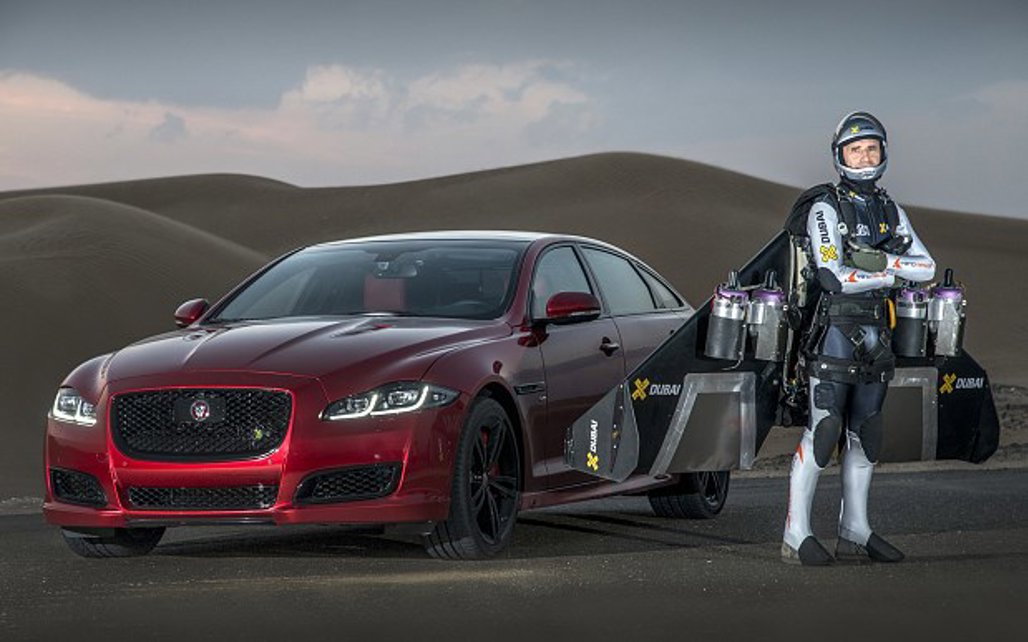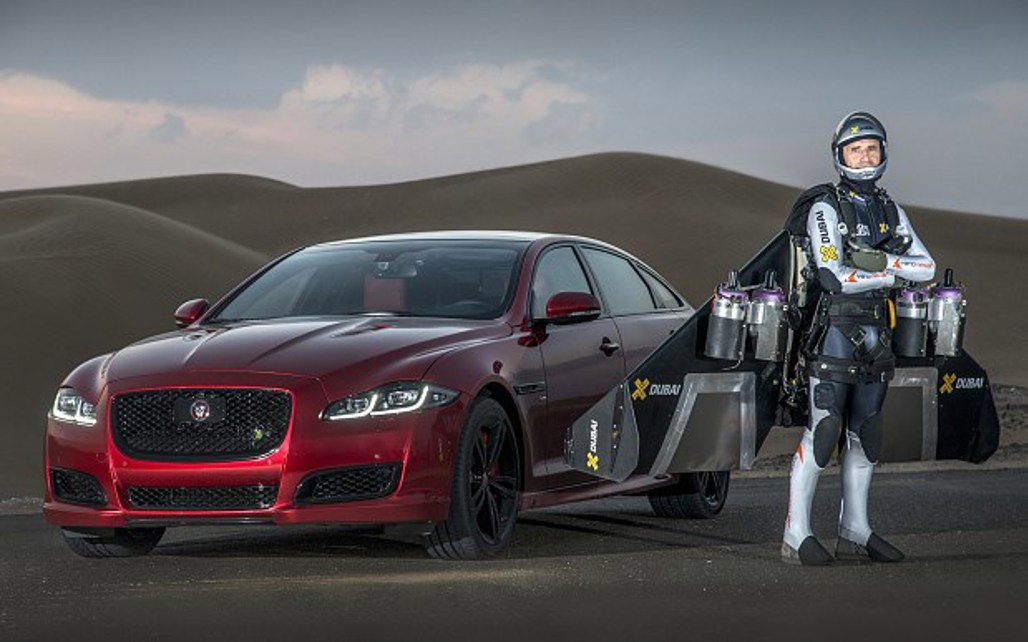Former F1 ace turned commentator, Martin Brundle, races the Jetman, and finds his supercharged V8 Jaguar has to play second fiddle in the desert
The steady thud of rotor blades gently fades as a helicopter rises into the sky, its roar replaced by the revving of a V8 engine. A race like no other is about to take place in the desert outside Dubai.
As the helicopter reaches 2,500ft, radios crackle and Yves Rossy – better known as the Jetman – launches himself into the air.
On the ground below, the supercharged V8 in a Jaguar XJR reaches a crescendo. Former Formula One star turned commentator Martin Brundle is behind the wheel and the car is accelerating hard towards the rising sun.
Meanwhile, the Jetman is in freefall, plummeting towards the ground at more than 160mph.
Strapped to his back is a two-metre carbon-fibre wing loaded with 25 litres of kerosene that power four Jet-Cat P200 engines. These engines are usually used to power drones used for target practice by the US military and they enable Rossy to exceed 200mph.
The 56-year-old started his aviation career in Swiss air force jet fighters before working as a commercial pilot. He only discovered what it really meant to fly after taking up parachuting.
“When I discovered skydiving it was the nearest thing to the dream because you are completely free,” he says. “But after 45 seconds of total freedom, which is absolutely fantastic, you have to open your parachute. After that it goes only in one direction… and that is down.”
For the past 20 years Rossy has been trying to find out how to fly with his body movements alone, without the sticks and pedals other flying vehicles rely on.
“The goal is to get back to the roots of flying. Birds don’t have steering things; they fly with their feathers,” he says. “With aerodynamics, technology and engine propulsion we can fly almost like birds, allowing it to follow our body movements.”
As technology has developed, so has his ability to fly. His suit, like the Jaguar he’s competing against, makes significant use of high-strength, low-weight materials, notably aluminium. The electronics, from remote starting for his jets to a head-up display (HUD), are as hi-tech as those in Brundle’s Jaguar.
For Rossy, the ultimate goal is fully autonomous flight without the use of a launch aircraft. “The goal is Ironman. Who doesn’t want to be Ironman?” he says.

As he drops from the helicopter above the desert, the roar of his four jet engines and an exhaust trail indicate his position, and after a rapid descent he straightens, locking on to the Jaguar below.
With the turn of his head or the raise of a shoulder, Rossy navigates the sky with the easy confidence of a veteran fighter pilot. Acrobatic spins and loops taunt the driver below as he shows off the skills that enable him to have three-dimensional movement.
Rossy’s descent gives him speed, but Brundle’s two-dimensional acceleration has put the Jaguar in front. The car’s computer-assisted low-speed traction aids give Brundle grip on the smooth but sand-strewn road while allowing him to get off to a cracking start. He has no problem reaching the car’s electronically limited top speed of 174mph before having to slow to 145mph for a right-hand bend covered in drifting sand and grit.
The car’s headlights cut through the early dawn, a time of day chosen as best suiting the Jetman. As Brundle focuses on the road ahead while trying to catch a glimpse of the Jetman above, Rossy gently rolls the throttle – the size of a radio dial attached to a finger on his right hand – and overtakes the speeding car, pipping it to the post.
Brundle says: “You’re racing somebody you can’t see. I was looking all over for him.

“He has to throttle back early on while you’re getting up to speed, because, of course, he is moving when the race starts. But at the end he was flat out and it was nip and tuck.
“He can also cut the corner. He didn’t have the gravel and sand in the turn, but the car was great.”
After winning the Le Mans 24 Hours for Jaguar in 1990, Brundle raced his winning XJR-12 endurance racing car against a Jaguar fighter jet. “I’ll never forget the afterburners as it overtook me at 200mph,” he said.
“I would like to have been a fighter pilot if I hadn’t done racing. And going up against Yves was fantastic.
“It’s the power and acceleration – his wings push him into the sky and, as racers, our wings push us into the ground. Power, aerodynamics and control. It’s the same thing, just a different dimension.”
-Daily Telegraph

